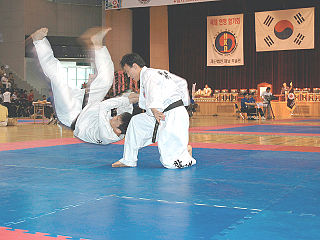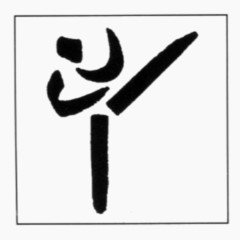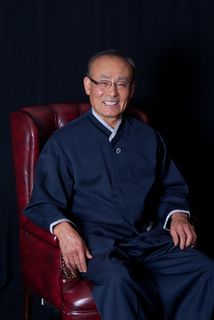
Taekwondo is a Korean martial art, characterized by its emphasis on head-height kicks, jumping and spinning kicks, and fast kicking techniques.

Hapkido is a highly eclectic Korean martial art. It is a form of self-defense that employs joint locks, grappling, and throwing techniques similar to those of other martial arts, as well as kicks, punches, and other striking attacks. It also teaches the use of traditional weapons, including knife, sword, rope, ssang juhl bong (nunchaku), cane, short stick, and middle-length staff, which vary in emphasis depending on the particular tradition examined.
Kumdo is a modern Korean martial art derived from Japanese Kendo. Though romanized in a number ways when written Kǒmdo or Geomdo the meaning remains "the way of the sword" and is cognate with the Japanese term. As a martial art, Kumdo has become accepted in Korean culture and society since its introduction from Japan to the degree that the term "Kumdo" has, in recent history, become a generic label for other Korean martial arts based upon swordsmanship. As a result, caution should be exercised to avoid confusion among practices espousing martial rather than sporting and competitive goals. Although related to Japanese Kendo, minor differences exist in Korean Kumdo due to appropriation and acculturation. Such differences include, but are not limited to, the use of native terminology, the use of blue flags rather than red flags for the referees and minor modifications to the uniform.

David Dilley Bannon, nicknamed Race, is an American author and translator. Bannon was convicted of criminal impersonation in 2006. His daughter, Jessica Autumn Bannon, died on January 16, 2015.
Soo Bahk Do is a martial art founded and taught by Kwan Jang Nim Hwang Kee, his successor Hwang Hyun Chul, known as H.C. Hwang, and instructors who are certified by member organizations of the World Moo Duk Kwan, Inc. This martial art was originally the ancient martial art of Korea. Hwang Kee created Moo Duk Kwan with influence from "Soo Bahk Do."
This is a list of Korea-related topics beginning with D. For Korean words starting with ㄷ, see also under T

Han Moo Kwan, alternately The World Taekwondo Han Moo Kwan Federation, was founded in August 1954 by Kyo Yoon Lee and is one of the nine original Kwans that later formed Kukkiwon Taekwondo.
Hwang In-shik is a Korean actor and hapkido teacher. He is known for his work in various Hong Kong martial arts films such as Bruce Lee's Way of the Dragon, Jackie Chan's The Young Master and Angela Mao's Hapkido. He was awarded a 10th degree black belt, the highest rank possible in the art, by the World Hapkido Association.
Gongkwon Yusul is a modern Korean martial art system founded by Kang Jun in 1996. Its main influences include the martial arts of Hapkido, Hakko-ryu Jujutsu, Judo and Kyuk Too Ki. Gongkwon Yusul is a system which emphasises the application of striking, locking, and throwing techniques in practical, free-flowing fighting situations, rather than the static applications, more in common in traditional styles of Hapkido.
Kim Yoon-Sang, was one of the senior most students of founder of hapkido, Choi Yong-Sool (Hangul: 최용술), from the hapkido founder's latter years. He is the notable Korean martial artist as the founder of Hapki yusul.
Kwon Tae-man was an early Korean hapkido practitioner and a pioneer of the art, first in Korea and then in the United States. He formed one of the earliest dojang's for hapkido in the United States in Torrance, California, and has been featured in many magazine articles promoting the art.
Kim Moo Hong was one of the earliest students of Korean hapkido under the founder of the art Choi Yong Sul. He was a pioneer of the art opening one of the first schools for the art in Seoul. A great innovator he is credited with having helped develop the kicking system used in most hapkido schools today. He formed one of the earliest Korean organizations for the art, the Korean Hapkido Association.
Seo Bok-seob was the first student to study under hapkido founder Choi Yong-sool, with whom he founded the art's first school, the Daehan Hapki Yu Kwon Sool dojang in Daegu, Korea. Moving to Seoul he later became a professor of East Asian medicine and worked for a time at Kyung Hee University.

Taekwondo was a demonstration sport at the 1992 Summer Olympics in Barcelona. It was the second time that the sport was included in the Olympic program; it would become an official sport eight years later at the 2000 Games. A total of 64 men and 64 women competed in eight different weight classes. Each event featured a single-elimination tournament to determine the winner.
Koreans in Spain form one of the country's smaller Asian populations.

Hapkidowon (Hangul:합기도원) was founded by Hong Sik Myung in 1981 in the US state of Michigan. Hapkidowon is also known as World Hapkido Headquarters, and Foundation of the World Hapkido. Hapkidowon is the center of Hapkido instructor education, issues official instructor Dan and certifications, provides seminars and leads and guides the Hapkido organization and school. Hapkidowon train leaders of the art on sound mind, body and spirit in accordance with the principles of Hapkido. Hapkidowon focuses on unity and the interests of Hapkido artists. Hapkidowon rewards those who contribute to the improvement of the art, the community and Hapkidowon itself.

Sun Hwan Chung, also known as James Sun Hwan Chung, is one of the highest-ranking taekwondo grandmasters in the world. He is founder of the Moo Sool Do form of martial arts and is president of the World Academy of Martial Arts, LLC.

Sang Chul Lee is a Korean born Taekwondo grandmaster 9th Dan, US Olympic Taekwondo head coach, entrepreneur, and owner of the US Taekwondo Center. Sang Chul Lee is a leading taekwondo innovator and missionary and has played an instrumental role in the promotion and development of Taekwondo throughout the United States and the world.

Won Hwa Do(원화도) is a traditional Korean martial art, founded in 1972 by Bong-Ki Han. The name in Korean (Hangul) means "The Way of Circular Harmony". The basis of the art lies in circular movement by effectively utilizing full 360° rotations of the human body motion. This helps in conserving energy and reducing the risk of injury on the practitioner's joints often caused by use of linear force and impact. Won Hwa Do is often compared to hapkido and Taekkyeon which are also national martial arts of Korea. Although similar in several aspects, Won Hwa Do's Ha-Dan/Sang-Dan Hoe-Jeon-Gong-Bang techniques are a unique trademark which is not shared by the other Korean martial arts. Ha-Dan Hoe-Jeon- Gong-Bang has the practitioner rotating arms in a forward motion and Sang-Dan has them rotating it in a backward motion. These two form the bases of strikes, throws, blocks, counters, submissions and kicks in its diverse self-defense system and are the most fundamental and basic practice of Won Hwa Do.
The uniform pattern is also unique in that it contains diamond shaped patterns with green and maroon lines painted or sewn across it. Its belt system does not follow the traditional Japanese black belt curriculum and its forms (kata) are quite short in comparison to karate, taekwondo and hapkido. Won Hwa Do is a very unorthodox martial art as demonstrated by its breaking away from these norms but takes pride in having its own unique standard.










